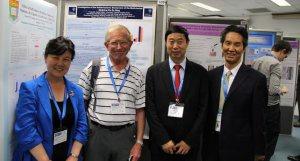他汀类药物通过降低肌肉能量产生引起肌肉疼痛
目前服用他汀类药物治疗高胆固醇症的病人或许会存在肌肉疼痛,近日,来自哥本哈根大学的研究者发现了病人出现肌肉疼痛症状的内在机制,相关研究成果刊登在了国际杂志Journal of American College of Cardiology上。
他汀类药物(statin)是一类通过抑制肝脏产生胆固醇的能力来治疗血液中高胆固醇的药物,其是市场上最有潜力的降低低密度脂蛋白的药物,目前将近有600,000名丹麦人每天服用该类药物来治疗高胆固醇症。
研究者Flemming Dela教授表示,我们都知道服用他汀类药物会引发肌肉疼痛,而且有75%的病人都经历着疼痛的折磨,如今我们的研究揭示了他汀类药物疗法可以影响肌肉能量的产生,这或许是直接导致病人肌肉虚弱和疼痛的原因。
研究中,研究者同样揭示了进行他汀类药物疗法的患者体内或许关键蛋白Q10的水平较低,肌肉中Q10的好进以及随既而来的低能量产生会许是引发许多病人肌肉疼痛的主要原因。在丹麦大约40%的病人进行他汀类药物疗法称为mono疗法,而且这仅仅是患高胆固醇病人使用的疗法,而且这些病人并没有其它影响心脏健康的风险因素。
在研究中,研究者以患者他汀类药物疗法为视角调查了其对病人的影响,结果发现接受他汀类药物疗法的病人,使用该疗法会影响其机体肌肉的能量代谢,从而导致患者出现肌肉疼痛症状,这就为研究者深入研究其发病机制提供了思路和线索。
Simvastatin Effects on Skeletal Muscle : Relation to Decreased Mitochondrial Function and Glucose Intolerance
Objectives: Glucose tolerance and skeletal muscle coenzyme Q10 (Q10) content, mitochondrial density, and mitochondrial oxidative phosphorylation (OXPHOS) capacity were measured in simvastatin-treated patients (n = 10) and in well-matched control subjects (n = 9).
Background: A prevalent side effect of statin therapy is muscle pain, and yet the basic mechanism behind it remains unknown. We hypothesize that a statin-induced reduction in muscle Q10 may attenuate mitochondrial OXPHOS capacity, which may be an underlying mechanism.
Methods: Plasma glucose and insulin concentrations were measured during an oral glucose tolerance test. Mitochondrial OXPHOS capacity was measured in permeabilized muscle fibers by high-resolution respirometry in a cross-sectional design. Mitochondrial content (estimated by citrate synthase [CS] activity, cardiolipin content, and voltage-dependent anion channel [VDAC] content) as well as Q10 content was determined.
Results: Simvastatin-treated patients had an impaired glucose tolerance and displayed a decreased insulin sensitivity index. Regarding mitochondrial studies, Q10 content was reduced (p = 0.05), whereas mitochondrial content was similar between the groups. OXPHOS capacity was comparable between groups when complex I– and complex II–linked substrates were used alone, but when complex I + II–linked substrates were used (eliciting convergent electron input into the Q intersection [maximal ex vivo OXPHOS capacity]), a decreased (p < 0.01) capacity was observed in the patients compared with the control subjects.
Conclusions: These simvastatin-treated patients were glucose intolerant. A decreased Q10 content was accompanied by a decreased maximal OXPHOS capacity in the simvastatin-treated patients. It is plausible that this finding partly explains the muscle pain and exercise intolerance that many patients experience with their statin treatment.
本站所注明来源为"爱爱医"的文章,版权归作者与本站共同所有,非经授权不得转载。
本站所有转载文章系出于传递更多信息之目的,且明确注明来源和作者,不希望被转载的媒体或个人可与我们
联系zlzs@120.net,我们将立即进行删除处理
热点图文
-
牛津大学:心速宁胶囊作用机制研究成果发表
2015年5月19日,由澳大利亚药理学会和英国药理学会主办的澳-英联合药理...[详细]
-
GM制药Epidiolex获FDA孤儿药资格
2月28日,GW制药宣布美国FDA授予该公司用于治疗儿童Lennox-Ga...[详细]


